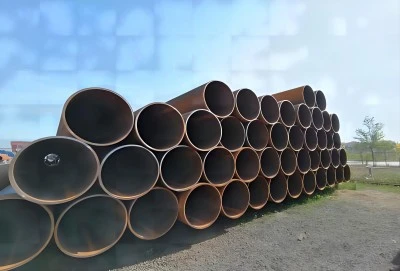The API 5L steel pipe detail stands as a significant standard inside the oil and gas segment, advertising basic orders for the generation, examination, and underwriting of consistent and welded steel line channels. This detail plays a basic part in guaranteeing the quality, execution, and security of steel channels utilized in different applications inside the industry, in this way underlining its centrality in keeping up operational measures and unwavering quality. Following the API 5L determination is principal to the judgment and usefulness of steel channels utilized in the transportation of oil and gas, reflecting the industry's commitment to brilliance and consistency.
|
|
|
Product Specification Level: PSL 1 and PSL 2:
The API 5L specification defines two product specification levels (PSL 1 and PSL 2), which apply to different applications and performance requirements. These levels allow for flexibility in the API 5L steel pipe selection based on the specific needs of a project while maintaining strict quality standards.
PSL 1 is the standard specification level and is suitable for most general pipeline applications. Pipes manufactured to PSL 1 requirements must meet basic chemical composition and mechanical property criteria. This level is often sufficient for many onshore pipeline projects and less demanding applications. PSL 1 pipes undergo standard testing procedures to ensure they meet the minimum requirements for strength, toughness, and dimensional accuracy.
PSL 2, on the other hand, is a more stringent specification level designed for applications that require higher performance standards. Pipes manufactured to PSL 2 requirements must meet additional criteria beyond those of PSL 1, including tighter controls on chemical composition, more rigorous mechanical testing, and enhanced quality control measures. PSL 2 pipes are typically used in critical applications, such as offshore pipelines, high-pressure systems, or environments where the consequences of failure could be severe.
The key differences between PSL 1 and PSL 2 include:
1. Chemical composition: PSL 2 has stricter limits on certain elements, such as carbon, phosphorus, and sulfur, which can affect the pipe's weldability and overall performance.
2. Mechanical properties: PSL 2 requires additional testing for properties such as yield strength, tensile strength, and impact toughness. These tests are conducted at both room temperature and lower temperatures to ensure the pipe's performance across a range of operating conditions.
3. Non-destructive testing: PSL 2 mandates more extensive non-destructive testing, including ultrasonic inspection for seamless pipes and full-body ultrasonic or electromagnetic inspection for welded pipes.
4. Traceability: PSL 2 requires enhanced traceability measures, including more detailed documentation and marking requirements.
5. Manufacturing process controls: PSL 2 imposes additional controls on the manufacturing process, such as tighter tolerances on dimensional variations and surface imperfections.
Size Range: Outer Diameter, Wall Thickness, and Length
The API 5L specification covers a wide range of pipe sizes to accommodate various pipeline applications. The outer diameter of the API 5L steel pipe ranges from half an inch (12.7 mm) to 40 inches (1016 mm), with corresponding standard specifications for wall thickness and length. This extensive size range allows engineers to select the most appropriate pipe dimensions for their specific project requirements.
Outer Diameter:
The outer diameter of API 5L specification is typically specified in inches, although metric equivalents are also provided in the standard. The available sizes cover a broad spectrum of pipeline applications, from small-diameter gathering lines to large-diameter transmission pipelines. Some common outer diameter ranges include:
1. Small diameter: 0.5 inches (12.7 mm) to 4.5 inches (114.3 mm)
2. Medium diameter: 4.5 inches (114.3 mm) to 16 inches (406.4 mm)
3. Large diameter: 16 inches (406.4 mm) to 40 inches (1016 mm)
Wall Thickness:
The wall thickness of the API 5L steel pipe is a critical factor in determining the pipe's pressure-carrying capacity and overall strength. The specification provides standard wall thickness options for each nominal pipe size, typically expressed in inches or millimeters. Wall thickness options are often categorized into schedules or series, such as:
1. Standard (STD)
2. Extra Strong (XS)
3. Double Extra Strong (XXS)
4. Schedule 10, 20, 30, 40, 60, 80, 100, 120, 140, 160
The selection of wall thickness depends on factors such as the design pressure, external loads, corrosion allowance, and safety factors required for the specific application. Engineers must carefully calculate the required wall thickness based on these factors and choose the appropriate standard option that meets or exceeds their requirements.
Length:
The API 5L specification also provides guidelines for standard pipe lengths, although these can vary depending on the manufacturing process and transportation considerations. Typical length options include:
1. Single Random Length (SRL): Usually between 16 feet (4.88 m) and 22 feet (6.71 m)
2. Double Random Length (DRL): Usually between 38 feet (11.58 m) and 44 feet (13.41 m)
3. Triple Random Length (TRL): Usually between 56 feet (17.07 m) and 66 feet (20.12 m)
The combination of outer diameter, wall thickness, and length options provided by the API 5L specification allows for great flexibility in pipeline design and construction. Engineers can select the optimal pipe dimensions to meet the hydraulic, structural, and economic requirements of their projects while ensuring compliance with industry standards.
API 5L Steel Pipe Manufacturers:
LONGMA GROUP, as an API 5L steel pipe manufacturer, offers a range of products that meet the stringent requirements of the oil and gas industry. Their manufacturing process likely involves advanced technologies and rigorous quality assurance procedures to ensure that each pipe meets or exceeds the API 5L specifications. The company's commitment to producing high-quality pipes is crucial for maintaining safety and reliability in pipeline operations.
For those in the process of choosing the product manufacturers, LONGMA GROUP invites potential customers to contact them at info@longma-group.com. This direct line of communication allows interested parties to inquire about specific product offerings, discuss technical requirements, and explore potential collaborations.














